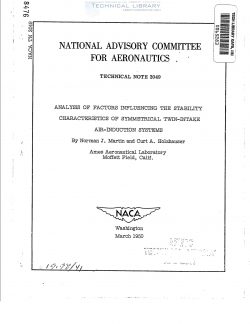naca-tn-2049
- Version
- 64 Downloads
- 873.64 KB File Size
- 1 File Count
- December 9, 2016 Create Date
- December 9, 2016 Last Updated
National Advisory Committee for Aeronautics, Technical Notes - Analysis of Factors Influencing the Stability Characteristics of Symmetrical Twin Intake Air Induction Systems

An analysis is made of the factors influencing the flow instability
and flow reversal which has been encountered experimentally at low inlet—
velocity ratios with several twin—intake air-induction systems. It is
shown that the flow instability and flow reversal are functions of the
static~pressure—recovery characteristics at the Juncture of the two ducts.
The method of analysis provides a means of predicting the inlet—velocity
ratio for flow instability and the inletiveloc'ity ratio for flow reversal.
Predicted results are in good agreement with the available experimental
data.
Experimental investigations of air—induction systems in which the air
flows of two intakes Join in a common duct have indicated that many of
these systems are subject to air—flow instability at low inlet-dvelocity
ratios. A particular type of instability, which is characterized by fluc—
tuations of the-quantity of flow in each duct and which usually results in
reversal of flow in one of the ducts as the system—inlet—velocity ratio is
reduced further, is the subject of this analysis. It has been observed
that this flow instability occurred when the intake pressure-recovery
characteristics were such that over a portion of the inlet—velocity—ratio
range the ram—pressure recovery increased with an increase of inletdvelocity
ratio.
A disturbance, such as a boundary—layer fluctuation, which would change
the aerodynamic symmetry would result in a decrease of inlet—velocity
ratio in one intake and an increase in the other. The intake having the
initial decrease of inletdvelocity ratio would have a decreased ram—
pressure recovery which in turn would tend to decrease further the mass
flow of that intake. The intake having the initial increase of inlet—
velocity ratio would have an increased ram—pressure recovery which would
tend to increase further the mass flow of that duct. As a result, the
intakes would continue to operate at increasingly different inlet—velocity
ratios and the possibility of flow reversal in one of the intakes would
exist. Thus, the ram—pressure recovery which increases with increasing
mass—flow ratio has a destabilizing effect on the air flow through the
ducts.
| File | Action |
|---|---|
| naca-tn-2049 Analysis of Factors Influencing the Stability Characteristics of Symmetrical Twin Intake Air Induction Systems.pdf | Download |

Comment On This Post